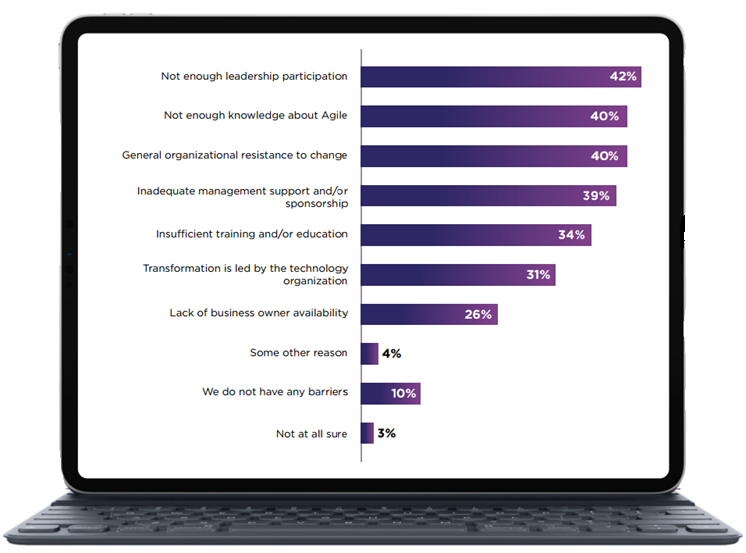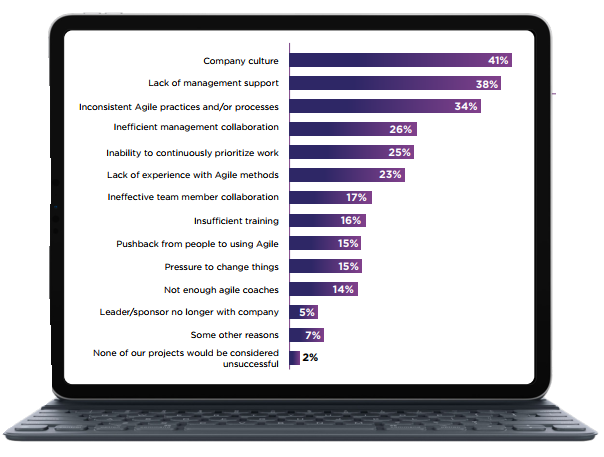Deliver better solutions, in less time, at lower cost, more predictably, with less risk. Faster time-to-market, increased revenues, quality products, higher productivity, happier, more engaged employees.
These are all reasons to make the transition to Agility (e.g. Scrum, KanbanSAFe, Disciplined Agile, Lean development, etc.). Let's take a look at some interesting results from the 16th Annual State of Agile Report (2022) report providing the most comprehensive data for benchmarking your agile practices.
The report documents the experiences of over 3,220 business and IT professionals in a wide range of sectors worldwide.
Leaders: if you want to reap the benefits of agility, what are you going to do to avoid undermining your transition to agility? You have the power to avoid wasting a lot of time and money!
Successful transition to agility: The trend

According to 89% of survey respondents, high-performance teams in agile mode have people-centered values, a clear culture, tools and empowered leadership.
This means that when the transition to agility is made successfully, the benefits accrue not only to the individual, but also to the organization, providing a powerful incentive to invest and move forward.
What works well through agile practices and people

When respondents are satisfied with their organization's agile practices, they see, in order of importance:
- Increased collaboration; it's easier to get their work done with their peers,
- Better alignment with business needs,
- A better working environment,
- Greater visibility in the application of the development lifecycle,
- Faster responses to competitive threats,
- Enhanced user experience,
- Better customer service,
- More time for innovation,
- Increased product adoption,
- Increased revenues.
Solution development and delivery: How is work prioritized?
In addition to asking how they are evaluated, respondents were asked how they prioritize their work on developing and delivering solutions in order of importance:
- Prioritization by organizational objectives (e.g. business metrics, epic-related OKRs, NPS, value stream KPIs, etc.),
- Prioritization by end-user satisfaction (e.g. end-user survey results, NPS, etc.),
- Prioritization by time to deliver (e.g. Metrics related to individual projects, etc.).

What does NOT work well with agile practices and people

The challenges of a successful transition from the people's perspective
The other side of the agility adoption coin is where organizations see challenges. According to the survey, the: Culturethe Leadership and the consistency are the three main challenges for the successful adoption of Agility within an organization.
Agility is not something that companies intuitively understand. Agile coaches, consultants or leaders working to expand agile adoption must constantly ensure that executives and cross-functional colleagues understand what agile is and how it will affect their work, because annual statistics show that there is a need to improve "Business" understanding of agile.

There are also challenges when organizations want to extend Agile practices to other areas of the organization, such as, but not limited to, operations, engineering, human resources or marketing.
When specific questions were asked about the obstacles to agility adoption at within the organization, the top seven causes were, in order of importance:
- Not enough participation from Leadership,
- Lack of knowledge about agility,
- General organizational resistance to change (agility),
- Inadequate support and/or mentoring from management,
- Insufficient training/education,
- IT-led transformation,
- Lack of availability on the business side.

In addition to the lack of Agile leadership, corporate culture is another challenge raised. 40 % of those surveyed are not satisfied with the Agile method within their organization. The statistics show that Agile practices frequently run up against the corporate culture.
As a matter of fact, corporate culture is considered the "The main cause of Agility implementation failure" .
Management support is a common challenge. 38 % of those surveyed indicated that the " lack of management support "would be the main cause of unsuccessful deliveries in Agile mode " while two out of five respondents say that lack of management involvement is a barrier to Agile adoption. Responses relating to areas of opportunity:
- Corporate culture,
- Lack of support from management,
- Inconsistent agile practices and/or processes,
- Ineffective collaboration on the part of management,
- The inability to continually prioritize work,
- Lack of experience with agile methods,
- Ineffective collaboration between team members,
- Inadequate training,
- "Pushback" from people to the use of agility,
- The pressure to change things,
- Not enough agile coaches,
- Managers/sponsors who are no longer with the organization.

This seems to indicate that having " corporate champions " and senior management who understand and embrace the process, are indicators of success.even if agility is already working well at operational level (teams).

Over the years, I've observed and experienced all kinds of things in relation to Agility, its understanding, adherence and application. Visit corporate culturethe lack of knowledge about agility and the lack of management support are definitely in my personal Top 3.
The transition to agility is a journey, not a destination. Willpower, courage, "corporate champions" of agility, senior managers who understand and buy into the process, continuous [guided] experimentation, time, effort, a mindset." inspect and adapt The ingredients for success are "the right balance" and repetition.
In my view, agility is a means to an end, not an end in itself. Even in the presence of organizational challenges/blockers, nothing prevents delivery teams from self-organizing to deliver value. Like adopting Agile values and principles, setting up their own " Ways of Working "Let's start with a small perimeter. Let's start in a small perimeter, taking small steps at the operational level, i.e. at delivery team level.
What about you? How have you experienced or are you experiencing your transition to agility? The transition to "product" mode? How did you get through the organizational challenges?
Leaders: what will you do to avoid undermining your transition to agility?

About the author
With over 20 years of experience management Information Technology, Éric Auger helps companies accelerate their value delivery and optimize their organizational performance. IT consultant specializing in project management, Lean Six Sigma Green Belt Practitioner, Kanban management expert and Agility coachI combine strategy, tactics and operations to maximize your competitiveness in the digital age.
Passionate about digital transformationI work with organizations to optimize their value flowguaranteeing sustainable competitive advantage. I also like share my expertise and help professionals strengthen their skills in project management and agility.
Follow me for practical advice and proven strategies to make your projects a success.





